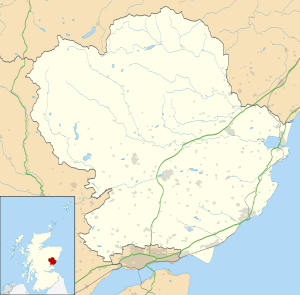Farnell Castle facts for kids
Quick facts for kids Farnell Castle |
|
|---|---|
| Farnell, Angus, Scotland | |
| Coordinates | 56°41′23″N 2°36′54″W / 56.6896°N 2.6150°W |
Farnell Castle is an old stone tower house in Scotland. It was built in the late 1500s. You can find it about four miles south of a town called Brechin in Angus.
Castle History
Farnell Castle stands on the site of an even older castle. This first castle was around in 1296. That year, King Edward I of England stayed there for one night. He was invading Scotland at the time. After his stay, he moved on to Brechin Castle.
The castle started out as a home for the Bishop of Brechin. A bishop is an important church leader. In 1512, Bishop Meldrum called it "Our Palace." Around 1566, the castle was no longer owned by the church. It became a regular castle owned by noble families. Catherine, Countess of Crawford, took it over. Later, the Earl of Southesk bought the castle.
In the 1800s, Farnell Castle was used as an "alms house." This was a place where poor people could live.
What the Castle Looks Like
Farnell Castle is a three-story building. It is made from rough stone and has a slate roof.
The eastern part of the castle was where the bishop lived. It has special roof edges called crow-stepped gables. These look like steps going up the side of the roof. On the north side, there's a part that sticks out called a garderobe. This was an old-fashioned toilet with a chute for waste.
On the east side, you can see two rows of stone supports called corbels. These stones stick out from the wall. They might have held up a covered walkway or gallery. At the top corners of the north side, there are small carved shields. One has the letter "M" with a crown, and the other has "I.M." People think "I.M." stands for "Jesu Maria." There is also a round stair tower at the front of the castle.
Farnell Castle is a "Category A listed building." This means it is a very important historic building that is protected.
In the castle grounds, there is also a ruined dovecot. A dovecot is a small building where pigeons or doves were kept. This one is rectangular and has stone walls.


